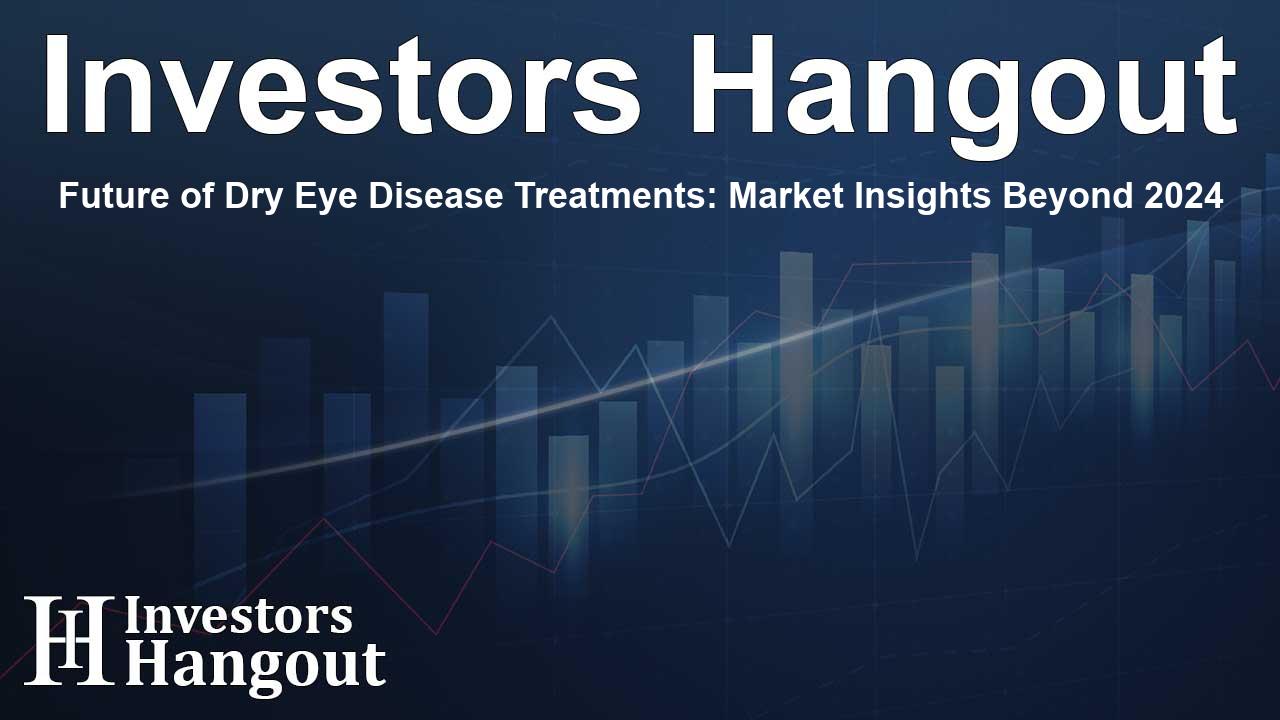Future of Dry Eye Disease Treatments: Market Insights Beyond 2024

Introduction to the Dry Eye Disease Market
In the evolving world of healthcare, the dry eye disease (DED) market is on the verge of remarkable growth. Numerous innovative therapies are set to emerge, promising to enhance treatment outcomes for millions battling this common ailment. According to recent analyses, the period from 2024 to 2034 presents an optimistic forecast, with substantial advancements expected as new drugs enter the marketplace.
Current Landscape of Dry Eye Disease Treatments
Dry eye disease affects millions globally, caused by insufficient tear production or increased tear evaporation. This condition often leads to inflammation and further complications. The typical symptoms include persistent dryness, irritation, redness, and occasionally excessive tearing. As more individuals rely on digital devices, the prevalence of DED is projected to rise, making effective treatment solutions increasingly critical.
Market Size and Dominance
The current market size for DED is estimated at around USD 3.7 billion, with certain regions, particularly the United States, accounting for roughly 73% of this market. This significant share highlights the urgent need for effective management and treatment strategies in areas where the condition is most common.
Pipeline Therapies and Upcoming Innovations
Exciting developments are underway, with leading companies like Palatin Technologies, Aldeyra Therapeutics, and ReGenTree investing heavily in innovative DED therapies. Potential game-changers include PL9643, Reproxalap, and RGN-259, among others, which promise to revolutionize how this condition is managed. These therapies address various underlying mechanisms of the disease, thus enhancing patient outcomes.
Historical Trends and Epidemiological Insights
The epidemiology of dry eye disease is complex, affected by age, gender, and environmental factors. Studies indicate the diagnosed prevalence of DED in the seven major markets (7MM) has approached around 54.6 million cases as of the latest evaluations. Understanding these trends is crucial for anticipating future market needs and tailoring treatment options accordingly.
Clinical Management and Treatment Options
Managing dry eye disease involves a multifaceted approach. Artificial tears are commonly used for immediate relief, while newer therapies like cyclosporine (RESTASIS) and lifitegrast (XIIDRA) target inflammation and provide longer-lasting relief. Furthermore, severe cases may require surgical interventions or advanced therapies, signifying a shift toward personalized patient care.
Recent Innovations and Future Outlook
Recent advancements, including those targeting viral keratoconjunctivitis with unique formulations, showcase the potential for broader treatment capabilities. Solutions like Marinomed's MAM-1001-3, with its antiviral properties, highlight the industry's forward-thinking approach to comprehensive patient care.
Future Trends and Market Dynamics
As we look ahead, several factors will influence the DED market dynamics. The increasing aging population creates a heightened demand for effective interventions. Public awareness campaigns are crucial in advocating for diagnosis and treatment, while collaborations among stakeholders in the pharmaceutical and healthcare sectors will be essential for innovation.
Conclusion
With the continuous development of novel therapies and a deeper understanding of dry eye disease, the future of this market is bright. Innovations are not merely aimed at enhancing patient comfort but also seek to improve overall quality of life. As the market expands, we anticipate a surge in both treatment options and patient support systems, leading to a healthier population.
Frequently Asked Questions
What is dry eye disease?
Dry eye disease is a condition characterized by insufficient tear production or excessive evaporation of tears, leading to inflammation and discomfort.
What causes dry eye disease?
Factors include aging, hormonal changes, environmental conditions, prolonged screen use, and certain medications.
What are the common treatments for dry eye disease?
Treatment options range from artificial tears and prescription medications to advanced therapies targeting inflammation.
How prevalent is dry eye disease?
Recent assessments indicate approximately 54.6 million diagnosed cases of dry eye disease across major markets.
What innovations are expected in the dry eye disease market?
Emerging therapies targeting unique mechanisms of DED and advancements in treatment methodologies are anticipated to shape future patient care.
About The Author
Contact Olivia Taylor privately here. Or send an email with ATTN: Olivia Taylor as the subject to contact@investorshangout.com.
About Investors Hangout
Investors Hangout is a leading online stock forum for financial discussion and learning, offering a wide range of free tools and resources. It draws in traders of all levels, who exchange market knowledge, investigate trading tactics, and keep an eye on industry developments in real time. Featuring financial articles, stock message boards, quotes, charts, company profiles, and live news updates. Through cooperative learning and a wealth of informational resources, it helps users from novices creating their first portfolios to experts honing their techniques. Join Investors Hangout today: https://investorshangout.com/
The content of this article is based on factual, publicly available information and does not represent legal, financial, or investment advice. Investors Hangout does not offer financial advice, and the author is not a licensed financial advisor. Consult a qualified advisor before making any financial or investment decisions based on this article. This article should not be considered advice to purchase, sell, or hold any securities or other investments. If any of the material provided here is inaccurate, please contact us for corrections.
